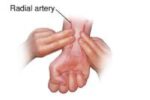Courtesy of Dr. Carlos Fava. Health system costs have increased significantly and there have been attempts to reduce it without compromising the quality of PCI outcomes. The benefits of the transradial approach combined with same day discharge could help reach this goal. This study included 279,987 MEDICARE PCI procedures where costs were analyzed. Cases...
Right vs. Left Transradial Access for Coronary Procedures
Courtesy of Dr. Guillermo Migliaro. Coronary angiography and angioplasty via transradial approach are associated with a significant reduction in access site complications, compared with transfemoral and transbrachial access. Moreover, a significant reduction in mortality has been reported for procedures performed via transradial approach vs. transfemoral approach in primary angioplasty. There is a limited number...
The radial access is a viable alternative in infarction complicated with cardiogenic shock
Original title: Arterial access site utilization in cardiogenic shock in the United Kingdom: Is radial access feasible? Reference: Mamas A. Mamas, et al. Am Heart J 2014;167:900-08 Cardiogenic shock in the context of acute myocardial infarction is associated with high mortality, and represents approximately 10% of major bleeding complications. Radial Access reduces mortality mainly by reducing bleeding; however,...
Transcatheter Aortic Valve Replacement showed better results than conventional surgery in high risk diabetic patients.
Original title: Transcatheter Versus Surgical Aortic Valve Replacement in Patients With Diabetes and Severe Aortic Stenosis at High Risk for Surgery An Analysis of the PARTNER Trial (Placement of Aortic Transcatheter Valve). Reference: Lindman BR et al. J Am Coll Cardiol. 2014 Mar 25;63(11):1090-9. Diabetes is associated to greater morbidity and mortality after surgical aortic valve replacement (SAVR),...
The radial approach for PCI reduces mortality
Original title: Radial Versus Femoral Access for Primary Percutaneous Interventions in ST-Segment Elevation Myocardial Infarction Patients. A Meta-Analysis of Randomized Controlled Trials. Reference: Wassef Karrowni et al. J Am Coll Cardiol Intv 2013;6:814–23. Bleeding is the most frequent in-hospital complication of PCI, and it is clearly associated with adverse events that include death. STEMI patients require emergency...
Percutaneous Left Atrial Appendage Suture: more options in atrial fibrillation patients with antiguagulation contraindication
Original title: Percutaneous Left Atrial Appendage Suture Ligation Using the Lariat Device In Patines UIT Atrial Fibrillation Reference: Krystof Bartus, et al. J Am Coll Cardiol 2013;62:108–18. Atrial fibrillation (AF) is the most frequent arrhythmia and is associated with a 5 fold increase in stroke risk and the resulting morbimortality. Warfarin anticoagulation therapy can be effective but only...
The radial artery is the default access for Europe.
Original title: Consensus document on the radial approach in percutaneous cardiovascular interventions: position paper by the European Association of Percutaneous Cardiovascular Interventions and Working Groups on Acute Cardiac Care and Thrombosis of the European Society of Cardiology. Reference: Martial Hamon et al. EuroIntervention 2013; 8-online publish-ahead-of-print January 2013. The European Society of Cardiology (ESC) recently published a consensus...
Radial Approach, 1st choice in Acute Coronary Syndromes
Original title: Radial Versus Femoral Randomized Investigation in ST-Segment Elevation Acute Coronary síndrome. The RIFLE-STEACS (Radial Versus Femoral Randomized Investigation in ST-Elevation Acute Coronary Syndrome) Study. Reference: Enrico Romagnoli et al. J Am Coll Cardiol 2012;60:2481–9. Bleeding in patients with acute coronary syndromes (ACS) is an independent predictor of morbidity and mortality. Until today, evidence supporting the radial...







